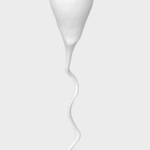
Technichal Specifications
How to use this exercise?
The size relationships between ovum and sperm should be made visible and touchable. The ovum is the only cell in the human body that is visible without a magnifying glass. Therefore, the students can use the enlarged print of the ovum to get a better idea of the original size of a sperm.
Number of pieces of this exercise
2
General description
Sperm:
Head: ovate, 0.3 cm long
Flagellum: 3 cm long, about max. 1 mm in diameter
The sperm should lie on the ovum to fix the flagella and make it more stable.
It should be about 15 sperms distributed on the ovum.
The head of one single sperm should be dived half in the ovum.
Surface of the ovum: irregular
Additional Material
Models used:
License Info
Attribution 4.0 International (CC BY 4.0) https://creativecommons.org/licenses/by/4.0/You are free to:
Share — copy and redistribute the material in any medium or format
Adapt — remix, transform, and build upon the material
for any purpose, even commercially.
Under the following terms:
Attribution — You must give appropriate credit, provide a link to the license, and indicate if changes were made. You may do so in any reasonable manner, but not in any way that suggests the licensor endorses you or your use.
No additional restrictions — You may not apply legal terms or technological measures that legally restrict others from doing anything the license permits.
Learning Specifications
How can the model be used in class?
Previous knowledge:
• The students already know the anatomy of the female sex organs.
• They have knowledge about
- the menstrual cycle with ovum maturation and ovulation
- changes in the endometrium.
Subject of the exercise:
• Fertilization of the ovum and subsequent implantation of the fertilized ovum in the uterine mucous membrane
Teaching course plan:
• After ovulation, the ovum is in the Tuba uterina.
• The sperms have to get over a long distance to get to the ovum. Recurrence of female sexual organs → way of the sperm through the vagina, cervix, uterine cavity and fallopian tubes.
• The sperm cells need a lot of energy and only a few of them reaches their destination.
• Construction of a sperm: head, transition piece and tail, nucleus with genetic information in the head, movement of sperm by self-movement of their scourge, energy production for these movements takes place in the mitochondria in the transition piece
• Before a sperm cell can melt together with the ovum, it must penetrate the outer layers of the ovum. Only then it can pass through the ovum cell membrane.
The ovum cell responds with a depolarization that prevents the penetration of other spermatozoa (only very briefly, as not relevant for our students).
• After conception, the cell nuclei of the two germ cells fuse together, the fertilized egg cell begins to divide and enters the uterine cavity, where it is implanted in the endometrium.
What benefits can its use have?
- The size relationships between ovum and sperm should be made visible and touchable. The ovum is the only cell in the human body that is visible without a magnifying glass. Therefore, the students can use the enlarged print of the ovum to get a better idea of the original size of a sperm.
- The model also helps students better understand that despite the large amount of sperms, only a single one can penetrate the membrane of the ovum.
- Students understand what conditions must be met for the fusion of ovum and sperm cells. This will allow them to develop a better understanding of the subsequent contraceptive topic.
Can it be used in other subjects?
Medical assistants, medicine.
